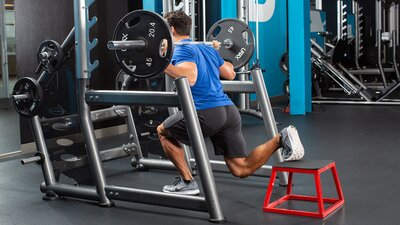Peruse any comment threads on basically any of the articles on fitness websites, and you'll see a spicy blend of half-truths, total mistakes, and "I don't think that word means what you think it means" moments, all popping into existence in real time.
For those of us who have worked as coaches and writers for years and years, it isn't easy to watch. Sometimes, it feels like the only options are to wade in and start correcting people—in other words, looking for a fight—or just to stay out of the comments altogether and get cynical and hopeless.
But there's a third option. Let's lay out the most fundamental training terms that will inform the vast majority of what you do in the gym, particularly if your goal is to build muscle or get stronger.
Types of Reps and Contractions
Use this as a basic guide to help your workouts or self-made programs fit your goals.
Concentric Contraction: This is when a muscle shortens in length. This is the "lifting" phase of a rep—think of your biceps when you're raising a bar doing a curl. Some exercises are actually concentric only, like sled pulls.
BodyFit Plans That Feature Concentric-Focused Training:
Eccentric Contraction: This is when muscle increases in length while under tension. It's the "lowering" phase of a lift. Think again of your biceps when you straighten your arms on the negative phase of the curl. If you just drop the bar, that isn't much of an eccentric. But you actually have more strength eccentrically than concentrically, which is why coaches will use tools like slow eccentrics to help bult strength and muscle.
However, eccentric-focused training also inflicts more muscle damage and can make you more sore than concentric-focused training.
BodyFit Plans That Feature Eccentric-Focused Training:
- Garage Gains: Dynamite Dumbbell Workouts for Size
- Blood and Guts: Dorian Yates' 6-Week Training Program
Isometric Contraction: This is when muscle does not change in length while under tension. Think about pushing against a wall or holding a certain position in a squat for time. You could also add isometric pauses in the concentric or eccentric portion of a lift. Simply holding the top position of a pull-up is isometric, but if you hold it long enough that you end up slowly lowering, it becomes eccentric.
BodyFit Plans That Feature Isometric-Focused Training:
- Bodyweight Bodybuilding: 6-Week Mass-Building Calisthenics Program
- Maximum Muscle: 9-Week Advanced Training for Gains
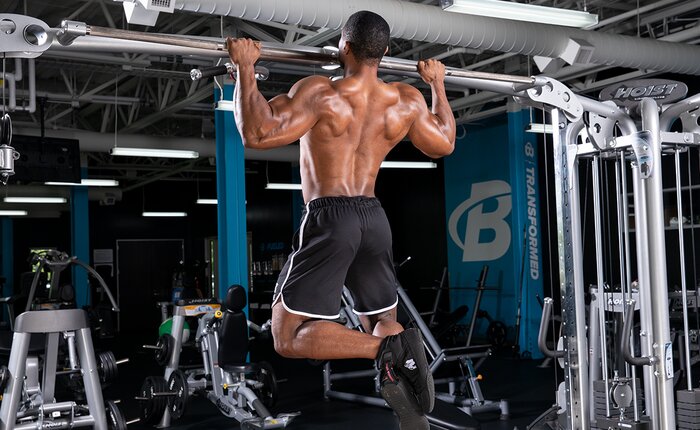
Isotonic Training: This is classic lifting, with reps that have both an eccentric and concentric component.
Isokinetic Training: This is when you use variable or accommodating resistance to create a situation where the harder you work, the more resistance you face. It often requires some specialized equipment, but swimming and certain types of stationary bikes can also create isokinetic reps.
Flexion vs. Extension
Think of the range of motion of a joint like an angle. Flexion, or flexing a joint, means making that angle smaller, and extension means increasing it. To be clear, our joints do more than just flex and extend (they also abduct and adduct, for example), but most of what we do in the gym focuses on flexing or extending joints like the hips, knees, shoulders, elbows, and spine.
However, which is which isn't always as clear cut as you may think. Contracting your biceps to flex your elbow? You know that one, even though you might mistakenly be calling it "flexing your biceps." Remember: muscles contract, joints flex.
But did you know that shoulder flexion involves raising your arm overhead, while shoulder extension involves moving your arms behind your torso? That one's not quite as intuitive.
What's more, unless you're doing nothing but single-joint moves all workout long—hopefully you're not—the lifts you do in the gym are combinations of several joints flexing and extending simultaneously.
For example, both squats and deadlifts are powered largely by knee and hip extension, but squats have more knee extension while deadlifts focus more on the hips. Now you know why people fight over whether a trap bar deadlift "counts" as a deadlift or if it's actually a squat.
My take, by the way, is that the trap bar lift is a deadlift–maybe the best damn deadlift variation out there for most people. Which is why I created "The Best Damn Trap Bar Workout, Period."

Regardless of whether you want to wade into those kinds of battles, being able to differentiate between knee and hip flexion, or spot spinal flexion when you're supposed to be doing hip extension, allows you to be a better analyst of your own form, and a more informed consumer of other people's fitness advice.
This can mean the difference between a healthy, strong, and technically sound big lift, and one that leaves you in pain.
Flexibility vs. Mobility
These are two terms that get thrown around a lot these days, and the difference isn't always clear. The difference between flexibility and mobility is basically that mobility is a more active application of movement focusing on a joint, while flexibility is more passive and focuses on a muscle.
More specifically, mobility involves moving a joint through its expected range of motion. Your shoulders or hips, to take two examples, can have limited mobility, adequate mobility, or even excessive mobility, which can put you at risk of injury.
Here's something that not enough people remember, though: Adequate joint mobility is contingent upon a proper balance of strength on each side of a load-bearing joint. That helps you build a combination of joint mobility with joint stability. Yes, you want both.
On the other hand, flexibility is just a way of quantifying your muscle's ability to tolerate being passively stretched.
In simple terms, you can keep your leg straight and put your heel up on a chair or ledge to create a hamstring stretch. That would demonstrate flexibility. Alternatively, using your hip flexors and quads to actively raise your leg into the same degree of stretch would be a demonstration of mobility. For the upper body, you could do the classic shoulder extension stretch, or you could try to improve your mobility with targeted work like an isometric shoulder extension.
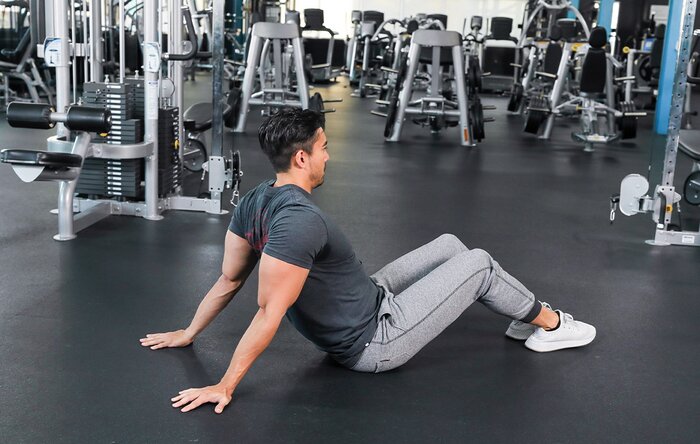
So, which deserves to be a higher priority in your training? For me, it's mobility, and here's why: Building mobility will help combat a lack of flexibility by developing your muscles on all sides of joints and helping them work together functionally. But it doesn't go both ways.
Sure, a lack of flexibility can impact your joint mobility, but you could stretch those muscles for years—and many do—and never see it carry over into adequate joint mobility. And if you stretch a muscle over an immobile joint, you can end up doing more harm than good.
Here's a helpful way to think of it: Mobility means having access to strength in all the right places. As you build it, through well-structured training and targeted warm-ups, it will pay off across the board.
All of this is why I recommend a mobility-focused approach, not only for people who hang out in gyms all day, but for everyone else, too–like I explain in my article "The Desk Jockey's Guide to a Jacked Physique."
Supersets vs. Compound Sets
Dig around into online workouts, and you'll see plenty of different exercise groupings called a "superset." Bis and tris? That's a superset. But what about bis and… bis?
Often, workouts use the term "superset" to describe any exercise immediately followed by any other exercise, with no break between. That's only partly right.
Supersets are pairings that group non-similar or non-competing muscle groups. The most popular version of this is the classic "antagonistic superset" involving a set for an opposing muscle group. Think chest press for the pecs and seated rows for the upper back, or biceps curls paired with cable push-downs.
When performing a chest press and then following it up with push-ups, however, you're working the same muscles twice. That's called a "compound set," not a superset.
Whereas supersets are great for workouts targeting two muscle groups, compound sets are ideal for workouts hammering a single muscle group, like those in the program Garage Gains: Dynamite Dumbbell Workouts For Size that I created with Bodybuilding.com.
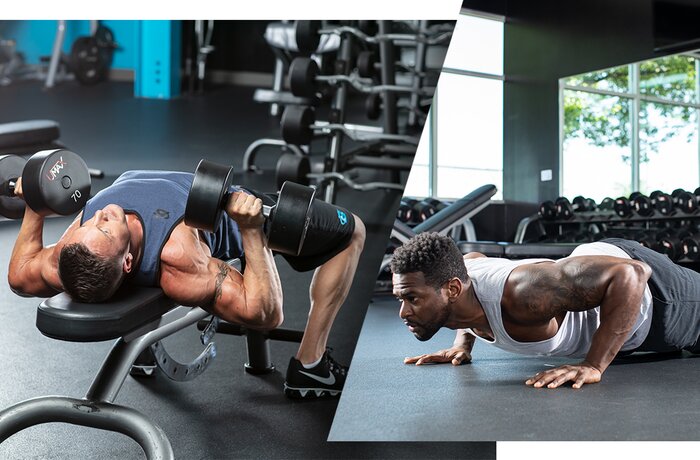
Here's where it gets confusing. If you add a third exercise to your compound set, that's a triset. Four or more is a "giant set," although plenty of lifters call anything that's three moves and above a "giant set." On the other hand, three or more exercises for unrelated muscles is a "circuit."
Now you know. But don't expect to see those terms used consistently out there in the world.
Muscle Failure vs. Technical Failure
Muscle failure refers to your muscles "shutting down" because they don't have any more power to supply against the resistance that's challenging them. Think about getting pinned in a bench press on your final rep and not being able to push it off your chest. Try as you might to get out another rep, you're done.
Technically, that's actually just "concentric muscle failure," because you still have more in the tank. Eccentric failure is a step further, where you can't even control the weight in the lowering portion anymore. That usually requires a spotter, and even then, it's a dangerous place to hang out unless you know what you're doing—and when to say when.
So, what about when you don't have a spotter? You can train to "mechanical" or "technical" failure, where you go to the point where you're unable to perform any additional reps with good form. Those last three words are the most important part.
Sure, you may be able to push for a couple more reps in that same bench press, but not without them coming at the expense of your shoulders losing their proper positioning, your elbows flaring, and your hips rising off the bench.
The more advanced you get as a lifter, the better you'll (hopefully) get at being able to gauge the point of technical failure. Stopping your sets before you hit muscle failure is a good policy in general, but it's essential for someone training on their own with no spotter.
Split Squats vs. Lunges
This one's pretty simple, but also very common. If you're in a split stance but your feet don't change position between your reps, you're not doing a lunge, you're doing a split squat.
On the other hand, if you reset your feet between each rep, then step forward or back to start a new rep, you're doing a lunge.
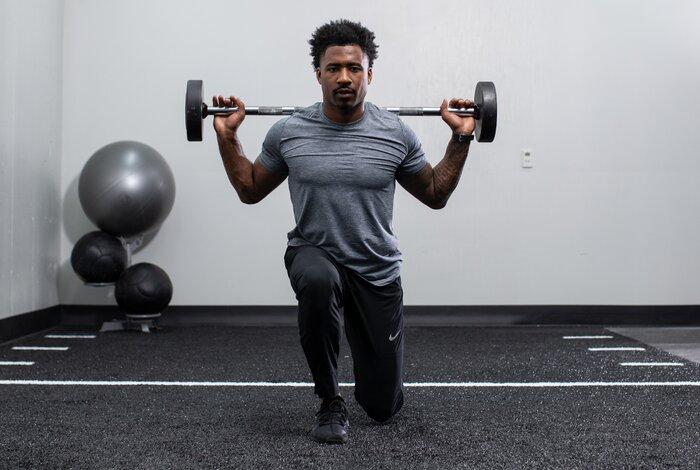
Of Course, There's Plenty More
Listen, before you flood my inbox with vitriol, I'm not going to pretend that these 1,800 words explain every single thing you'll ever need to know about training.
No, this isn't the full list. It's just the start, based on what I see get butchered most often, and what I see as having the greatest degree of "reach" and applicability to someone trying to get stronger and build muscle. You can take this information for what it is, or you can nitpick about why I don't think understanding Huxley's sliding filament theory or the Krebs cycle is quite as important for most people just looking for gains.
But whatever you do, don't let me catch you telling someone about your Bulgarian rear-foot-elevated lunges or reaching over your head to demonstrate shoulder extension. Because now you know better.

